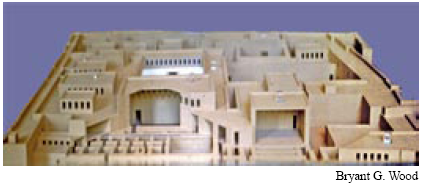This article was first published in the Winter 2005 issue of Bible and Spade.
The ancient city of Mari, located in northern Syria, was a thriving metropolis ca. 2800-1760 BC. From about 2000 BC until its demise in 1760 BC, Mari was the capital of the Amorites. Amorites were spread far and wide throughout the ancient Near East, including the hill country of Canaan vanquished by the Israelites (Nm 13:29; Jos 10:6). The French have been excavating Mari almost continuously since 1933. The major discovery was an enormous palace covering 6 acres, with nearly 300 rooms on the ground level and an equal number on a second floor. It was in use from ca. 2300 BC until its destruction by Hammurabi in 1760 BC. An archive of about 15,000 texts from the final years of the palace provides a detailed insight into the common social, economic and legal practices of that time. Contained in the archive are administrative and legal documents, letters, treaties, and literary and religious texts.

Reconstruction of the palace of Zimrilim, the ruler of Mari at the time it was destroyed in 1760 BC. Louvre, Paris.
The value of the Mari texts for Biblical studies lies in the fact that Mari is located in the vicinity of the homeland of the Patriarchs, being about 200 mi (320 km) southeast of Haran. It thus shares a common culture with the area where the Patriarchs originated. Some documents detail practices such as adoption and inheritance similar to those found in the Genesis accounts. The tablets speak of the slaughtering of animals when covenants were made, judges similar to the judges of the Old Testament, gods that are also named in the Hebrew Bible, and personal names such as Noah, Abram, Laban and Jacob. A city named Nahur is mentioned, possibly named after Abraham’s grandfather Nahor (Gn 11:22-25), as well as the city of Haran where Abraham lived for a time (Gn 11:31-12:4). Hazor is spoken of often in the Mari texts and there is a reference to Laish (Dan) as well. A unique collection of 30 texts deals with prophetic messages that were delivered to local rulers who relayed them to the king.
The findings at Mari show that the Patriarchal narratives accurately reflect the socioeconomic conditions of that time and place.
For further information, see: The Archive of Mari, by G. Herbert Livingston, Bible and Spade 5 [1992]: 105-108.
Recommended Resources for Further Study